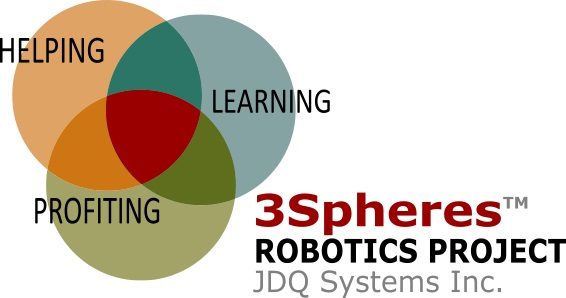DDA Annual Report Article – April 2019
In the 4th quarter of 2018, the 3Spheres Robotics Project team completed a 3-month, grant-funded, “focus group” study that compared and contrasted the robotics requirements for seniors living in eldercare rest homes with the requirements for people with developmental disabilities living in DDA group homes. The study concluded that there are a lot of similarities and it suggested that we need to narrow our research and hypothesis testing to include 4 basic types of collaborative service robot:
- The Entertainer, whose main purpose would be entertainment and redirection, in an effort to stimulate interest, calmness, companionship and joy.
- The Chaperone, who would help people get from A to B and encourage exercise, inside a building where GPS does not work. The goal is to increase independence by addressing forgetfulness, Dementia, and skill loss. The Chaperone would also help offset the caregiver shortage and walker congestion in common areas.
- The Safety Inspector, would spend its time looking for and reporting falls, aggressive behaviour, near misses and safety hazards. This robot would help alleviate the caregiver shortage and free up human caregivers so they can spend more quality time with residents.
- “Mother” would help people plan activities and appointments, remind them to do each task, and monitor the fulfillment of each activity. Integration with the Alchemist planning system and “unconditional love” are real possibilities for this robot prototype.
To that end, we are planning a Minimum Viable Experiment (MVE) to test 1 or 2 of the above hypotheses and determine the essence of what our robot, known as “Aether™”, should do for DDA.
The research team has also been working on several new skills over the last year, all designed to support the “Minimum Viable Experiment” we are planning for 2019, including:
- “Look at [person name]”: While staying in one place, Aether turns to keep following the named person. This combination of face recognition, gaze-cueing, body detection and tracking skills is indended to help all minimum viable robots gain and retain a person’s attention.
- “Follow [person name]”: As the command suggests, Aether will follow a recognized person, who is walking. This skill will soon be extended to following a person in a wheelchair and is a primary skill required for the “Chaperone” experiments.
- “Play Chase Me”: This is an exercise skill, intended for people that are walking or in a wheelchair. Aether adjusts its speed to the pace of the person it is chasing. Who knows, this may one day evolve into a fun game of “tag”!
- “Dual personality” robot mode: Just like humans, different robots have different expertise. Now you can choose to ask Aether for her skills of navigation, detection and recognition, or ask Alexa for her skills of general info, entertainment, and appointments. Using name association, we will test the hypothesis that this verbal interface makes it easier for humans to remember and execute Aether’s commands.
- “Label a hazard”: We quickly learned that there are several small object hazards in the group home environment that Aether needs to avoid or at least slow down for. We discovered that door sills, table tops, and even someone’s toe could trip up Aether. Staff can now label a hazard to keep Aether safe while on route to a destination or while doing a safety inspection” of multiple locations.
We look forward to demonstrating these new skills at the AGM!
